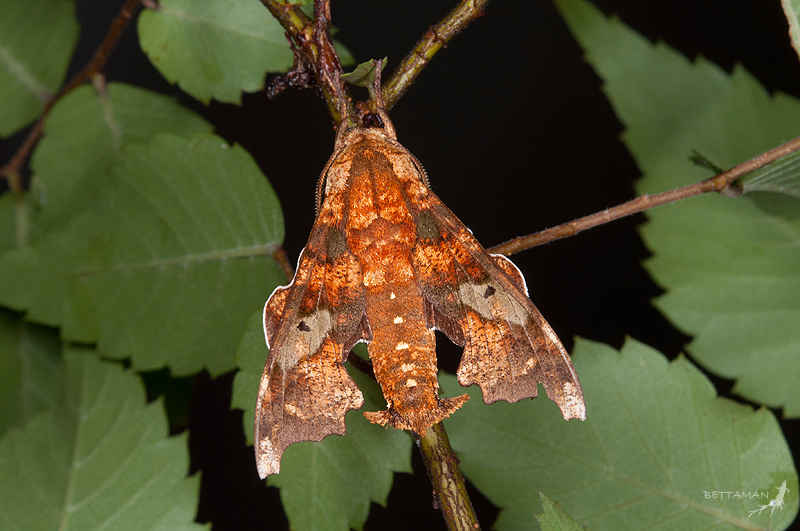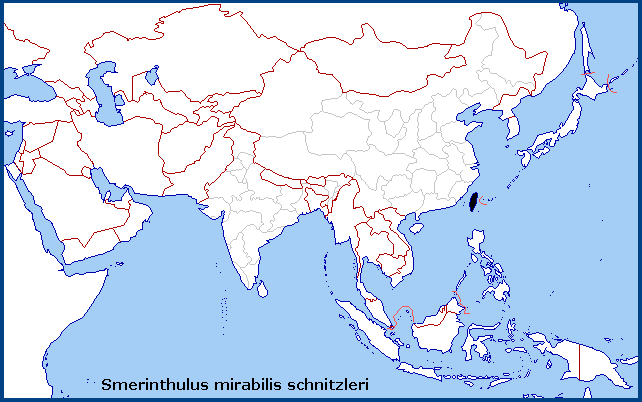Degmaptera schnitzleri Melichar & Řezáč, 2014, European Entomologist 5: 53. Type locality: Taiwan, Nan-To [Nantou], Pu-Li [Puli], Sang Gan [Songgang], 1.vi.2007.
Note. Rothschild & Jordan (1903) distinguished Degmaptera from Smerinthulus (in which they also included what are now classified as Cypoides chinensis and Morwennius decoratus) solely by 'the hindwing being produced frontad near apex into a rounded lobe, the costal margin more or less sinuate proximally of this lobe, vein C [the costa] almost following the curve of this lobe, not straight as in Cypa and Smerinthulus'. However, a strongly developed lobe is only found in male Degmaptera mirabilis (Rothschild, 1894); that of the female is much less curved, and the costal margin of both sexes in Degmaptera olivacea is almost straight. On the basis of similarities in habitus, male genitalia and DNA barcode sequences, Brechlin (2014) transferred Degmaptera cadioui, Degmaptera laotiana and Degmaptera olivacea to Smerinthulus, leaving only the type species, Degmaptera mirabilis and the closely related Degmaptera schnitzleri in Degmaptera. However, using the same reasoning, there was no reason for not transferring Degmaptera mirabilis and Degmaptera schnitzleri as well, and synonymizing Degmaptera with Smerinthulus.
Thus Degmaptera was transferred to Smerinthulus by Brechlin, 2016, Entomo-Satsphingia, 9(4): 87. Then the now Smerinthulus schnitzleri was synonymized with Smerinthulus mirabilis as a subspecies by Haxaire, Melichar, Kitching & Brechlin, 2022, European Entomologist, 14(1+2): 14.
Note. The taxonomic situation of the various subspecies of Smerinthulus mirabilis is problematic. As this moth flies only at elevations exceeding 1000 meters, it is likely that isolated populations are found in all mountain ranges in Southeast Asia and southern China. These populations are all likely to be slightly different genetically. Thus, with the intensification of collecting, there is the possibility of creating different subspecies for each mountain range, or even on each mountain if the genetic (and morphological) interpretations are pushed too far, and if limits are not defined. Hence Haxaire, Melichar, Kitching & Brechlin, 2022, viewed the various subspecies, whose genital morphologies are otherwise identical and whose appearances are extremely similar, with a considerable degree of scepticism. When one must look at the origin of a specimen to give it a name, then there is an obvious problem. Nevertheless, for the time being, they maintained the various entities as subspecies.
Wingspan: 44--82mm. Forewing upperside deep ferruginous-red, variegated with ochreous and orange-yellow, with a fawn-colored band just beyond the cell; discal spot black with a minute transparent centre. Hindwing deep reddish-brown, with traces of red median and submarginal bands. Costal edge excavated resulting in a conspicuous subapical lobe, which projects anteriorly, as in Smerinthulus olivacea. Abdomen upperside with a central row of pale golden dots.

The moth rests with the wings horizontal and held so that the lobe of the hind wing projects well in front of the costa of fore wing; the abdomen is left uncovered and bent upwards.
Taiwan: 25.iii.2019 (Ren'ai township); 18.iv.2012 (Tianwan); 1.vi.2007 (Puli); 2.vi.2014 (Wangxiang); 27.xi.2011 (Kasuga township).
OVUM: In Smerinthulus mirabilis mirabilis, elongate-oval in shape, surface smooth and moderately shiny. Pale bluish-green when first laid, with reddish-brown markings developing later. These markings take the form of a narrow reddish-brown stripe running round the lower portion of the egg roughly parallel with the line of attachment to the leaf, and broken at each end of the egg. There is also a broad irregular stripe of a paler reddish-brown across the top, parallel with the long axis but slightly on one side of the centre line. Finally, there is a short, broad stripe of the same colour as and parallel with the longer stripe on the opposite side of the centre line.
In India, the eggs of Smerinthulus mirabilis mirabilis are laid singly, usually on the underside of a leaf of Quercus fenestrata Roxb. (Bell & Scott, 1937).
LARVA: Unknown.
PUPA: Unknown.
Larval hostplants. Unknown in Taiwan, but recorded on Quercus fenestrata in the Khasi Hills, India (Bell & Scott, 1937).
Unknown.
Taiwan: Taichung Hsien (Tashiiehshan, Anmashan, 2230m); Nantou Hsien (Puli; Xinyi township, Wangxiang, 2300m; Ren'ai township, Pinnacle forest road; Lingxiao Temple, 1307m); Yilan Hsien (Tianwan, 1050m); Pingtung Hsien (Kasuga township, Dahan Mountain forest road); Kaohsiung City (Taoyuan District, 1900m).
Endemic to Taiwan.
(The above records from Taiwan (and those from SE China) represent a considerable eastward extension of the previously known range for this species, which was Nepal, northeastern India and northern Thailand).

Holarctic; eastern Palaearctic region. Pleistocene refuge: Monocentric -- Taiwan refugium.
 Return to Sphingidae of the Eastern Palaearctic species list
Return to Sphingidae of the Eastern Palaearctic species list